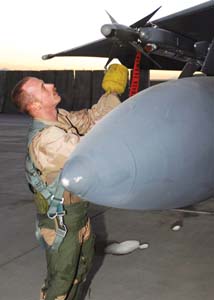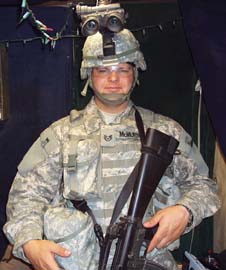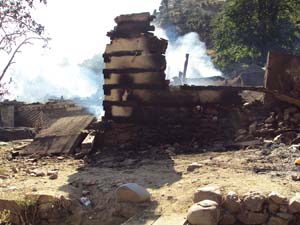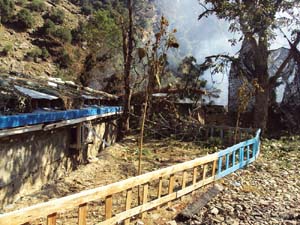Combat Outpost Keating—established in 2006 as a base for a provincial reconstruction team—was located in a “bowl” in Nuristan province, about 10 miles from the Pakistan border in northeastern Afghanistan. The isolated camp sat near the intersection of two rivers, surrounded by steep mountains known to be populated by Afghan civilians and insurgents, all of whom had an eagle-eyed view of troop movements below.
Initially troops were charged with befriending the locals and stopping illegal movement across the border, but conditions around the post soon began to deteriorate. The mission shifted from winning the hearts and minds of the local people to a purely defensive strategy.
 |
Capt. Michal Polidor removes a protective cap from the seeker head of an AIM-9 Sidewinder missile. ( Photo courtesy of SSgt. Matthew McMurtrey ) |
Over the course of at least 18 months, the outpost came under sporadic but increasing attack. Typically, a few insurgents would make their move, inflict as much damage as possible, and then disappear into the mountains a few minutes later.
Nothing prepared US forces for the massive and coordinated attack that came last Oct. 3, however. The final onslaught was well-planned and involved nearly 300 insurgents who had the base completely surrounded and refused to back down. Simply put, the troops at Keating were vastly outnumbered and they had nowhere to go.
Eight US soldiers were killed and 22 wounded during the massive, complex attack a year ago this month. Soldiers from Bravo Troop, 3rd Squadron, 61st Calvary, out of Ft. Carson, Colo., were pinned down early that morning. Roughly 80 US troops, outnumbered nearly four-to-one, were under fire from enemy fighters perched in the mountains overlooking the camp. The insurgents shot small-arms fire and rocket-propelled grenades down from all sides.
 |
|
Nearby Observation Post Fritsche, which was located on higher ground, offered some “overwatch protection” but not much, according to the executive summary of the Army’s investigation of the attack, provided by NATO’s International Security Assistance Force-Afghanistan. Insurgents simultaneously attacked Fritsche that day, limiting mortar support to Keating.
Those on the ground say the casualties in the 12-hour battle would have been much greater without airpower. In fact, the outpost probably would have been completely overrun if not for the intervention of Air Force and Army aircraft.
Nineteen aircraft, both Air Force fixed wing and Army helicopters, flew close air support missions during the desperate battle. Roughly 150 insurgents were killed, and the troops were able to hold on.
“There is no doubt that without the incredible air support we received, it would have been a much worse day,” Army Lt. Col. Robert B. Brown, who served as the 3-61 Cavalry commander during the battle, said in a release issued at the time. “Your ability to keep a steady flow of aircraft and ordnance on the enemy turned what could have been a terrible defeat into a hard fought victory.”
A Mission Unclear By the time soldiers from B Troop deployed to Keating in 2009, both US and Afghan National Army manning had dried up significantly, and the soldiers struggled to grasp why they were still there.
 |
|
“The mission for COP Keating during the rotation of B Troop was unclear to the soldiers … who understood counterinsurgency doctrine and the need to engage with and protect the local population,” read the Army’s investigation. “But owing to limited manpower and tactical reach off of the compound, the mission devolved into one of base defense, and by mid-2009, there was no tactical or strategic value to holding the ground occupied by COP Keating.”
Commanders had already decided to close the remote camp as part of a new Afghanistan strategy to pull troops away from austere outposts and put them back into larger population centers. The closure, originally slated for July to August 2009, was delayed because “assets required to backhaul base supplies were diverted to support intense brigade-level operations in Barg-e Matal,” the summary stated.
Intelligence-surveillance-reconnaissance assets also were “reprioritized” to support Barg-e Matal, a village located just north of the Kamdesh Valley, where Keating was based. The ISR assets also were to be used to help locate a missing US soldier in southern Afghanistan, according to the summary. The additional equipment could have given Keating’s ground forces more situational awareness, but it is not clear that would have made a significant difference in the battle that followed.
 |
|
Over B Troop’s five-month deployment to Keating, insurgents launched 47 attacks against the post—three times the rate of attacks against their predecessors, according to the Army. On several occasions, intelligence reports indicated “a large enemy force” outside Keating’s perimeter, but each time only a few fighters would attack using indirect and small-arms fire. The engagements themselves typically only lasted five to 10 minutes.
As a result, troops began to ignore intelligence reports of an imminent large-scale attack.
“Owing to this experience with the enemy in vicinity of COP Keating, the perception prevailed that reports of massing enemy forces were exaggerated and improbable,” according to the summary. “The focus became the enemy’s most likely, rather than his most dangerous, course of action.”
Air Force SSgt. Matthew McMurtrey, a cyber systems operator who was attached to the 3-61 Cavalry, jolted out of bed around 6 a.m. the day of the attack. The wall next to his bunk in the information technology building—where he both worked and slept—was shaking and the room was full of dust. He didn’t know it at the time, but there was a four-foot hole on the other side of the building where a rocket-propelled grenade had struck just a few seconds earlier.
Being Overrun McMurtrey quickly put his individual body armor over his physical-training gear, grabbed his M16 service rifle, and headed to his battle position—an aid station about 20 yards away. He was the lone airman on the ground that day. McMurtrey had deployed about three weeks prior, on his first combat mission from the 755th Air Expeditionary Group based at Bagram Airfield, to set up and maintain a satellite system used to provide troops Internet and phone access.
It was about 30 minutes before the first casualties began to arrive, but it didn’t take long for the scene to turn chaotic after that. An RPG struck a nearby wall, peppering several medics with shrapnel. An alternate aid station had to be set up on the front porch to accommodate the influx of wounded and killed.
McMurtrey, now assigned to the 624th Operations Center at Lackland AFB, Tex., offered assistance where he could—changing out IV bags, distributing supplies, and even clearing the weapons of the deceased and putting them in body bags.
“It seemed that it would get extremely intense, with a lot of fire, a lot of RPGs hitting the wall, and then it would die down,” McMurtrey said. “Basically, the air support was leaving and coming back. As soon as they left, the insurgents would come back.”
Citing operational security concerns, military officials declined to say exactly when airpower arrived on scene or what platforms were the first to arrive. But by 8 a.m., there were four F-15Es from the 455th Air Expeditionary Wing and several AH-64 Apaches circling the outpost and dropping munitions.
 |
|
Capt. Michal P. Polidor and then-1st Lt. Aaron Dove were sitting inside their Strike Eagle on the flight line at Bagram—about 100 miles away from Keating—waiting to head out on a routine patrol when they got the call for close air support. They were told Keating was “being overrun” with insurgents and that they needed to take off immediately, but few other details were relayed.
When they arrived on the scene about 10 minutes later, they were briefed by the first two F-15E pilots to arrive. That’s when the severity of the attack first started to sink in, Polidor and Dove said in separate telephone interviews.
“We were greeted with three radios that were busier than I could have ever imagined. They were all talking to us at the same time. It took 15 to 20 minutes just to sort out who was talking, where they were talking from, and what they were trying to say,” said Polidor. “We looked through our targeting pod, … and all you could see were muzzle flashes in the infrared. It was pretty much like the Fourth of July. It looked like fireworks coming out of the base up into the hills.”
Polidor, the pilot, and Dove, weapon systems officer, dropped several 2,000-pound guided bombs and then immediately assumed the role of tactical air controller airborne.
The first two F-15Es had just come off a night sortie and were running low on fuel, so one of the Strike Eagles flew back to Bagram, while the other stayed behind for another half an hour, orbiting high in the air above nearby FOB Bostick to conserve fuel while acting as a communication relay.
The steep mountains were making it difficult for aircraft to communicate directly with Keating, so one of them had to circle above the joint terminal attack controller at FOB Bostick, about 20 miles away. The JTAC at Bostick would get coordinates from soldiers on the ground at Keating and then relay that information to the aircraft above. That aircraft would relay the information to Polidor and Dove, who would then relay the information to whatever aircraft was next in line to drop munitions.
After Polidor and Dove dropped several 2,000-pound Joint Direct Attack Munitions and strafed the hillside where the soldiers were receiving heavy fire, they called for their wingman to drop his munitions. The second Strike Eagle dropped two guided bombs, but then had to return to Bagram because its hydraulic system was malfunctioning.
 |
|
When their wingman left, Polidor and Dove refueled, returned and dropped a few more bombs, then continued acting as the communication relay, before dropping one more set of munitions. In all, the radio tag continued for more than seven hours as the battle unfolded. (Polidor and Dove were later awarded Distinguished Flying Crosses for their actions that day.)
Around 9 a.m., a B-1 conducting a routine patrol about an hour away got the call that Keating was in trouble. The bomber, whose call sign was Bone 21, arrived a few minutes later and started listening to the radio traffic.
“Keating was packed full of jets, so we knew this was not an ordinary engagement,” said Capt. Justin Kulish, the B-1 pilot, who was assigned to the 379th AEW. “Once we got overhead the target, the biggest thing that struck me was how much of Keating was on fire. It seemed like the entire COP was burning.”
In fact, most of Keating was on fire. By this time, the building in front of the aid station where McMurtrey was stationed was burning, and the flames were so intense that troops on the ground feared the aid station would catch on fire. McMurtrey helped the medics move the casualties and equipment, one by one, about 20 yards away to a barracks—one of the few buildings untouched by flames.
Bone 21, which was fully equipped with 20 500-pound GBU-38s and 2,000-pound GBU-31s, dropped its first set of weapons and then flew off to refuel. The bomber had already been in the air for about nine hours before it arrived on scene, Kulish said.
Just before noon, a winter storm started to roll in from the west. There were clouds with embedded thunderstorms from 200 feet up to 30,000 feet, Kulish said. After the storm kicked in, the ground was no longer visible, so the aircraft could only drop GPS guided bombs—based solely on coordinates passed from troops on the ground, Dove said.
“Throughout the flight, [Dove] diligently used his aircraft’s sensors to minimize risk to friendly forces and mitigate civilian collateral damage,” according to his DFC citation. “He twice identified coordinate errors that were passed in the heat of battle and promptly directed attack aborts prior to release.”
Refueling also became difficult. The tankers had to move about 100 miles away, meaning it would take the jet aircraft about 15 minutes each way to refuel. Even then, the weather continued to cause problems.
16 Tons of Bombs, 170 Rounds Bone 21, which was starting to accumulate ice as it flew through turbulence, made several more runs. The bomber was able to drop the rest of its munitions after one temporarily aborted attack, then flew back to its home base after successfully completing a 16.5-hour sortie.
At the height of the battle, Polidor and Dove were directing 19 aircraft—all flying at varying altitudes above Keating. They “systematically ensured aircraft deconfliction in severe weather, orchestrating air strikes from six F-15Es, four A-10s, two AH-64s, and a B-1 to provide kinetic solutions,” according to a DFC citation.
As the battle waged on, many of the Afghan National Army soldiers abandoned their posts, allowing insurgents to penetrate Keating at three different locations. This forced the American soldiers to withdraw to a “tight internal perimeter,” according to the Army report. But thanks in large part to Air Force and Army airpower, US soldiers were able to fight back and regain control of key buildings throughout the afternoon.
In all, 16 tons of bombs were dropped on the enemy that surrounded and infiltrated COP Keating. The insurgents also were strafed by 170 rounds. According to the DFC citations, the combined effect of this airpower saved 72 lives.
“As evening fell on the night of 3 October 2009, COP Keating remained solidly under US control, and enemy forces had suffered severe tactical defeat,” according to the Army report, although “eight American soldiers made the ultimate sacrifice defending their outpost and their fellow soldiers.”
Troops on the ground spent the next three days gathering classified documents and weapons from the burned rubble as they waited for airlift to bring them out, said McMurtrey, who was awarded two Army Commendation Medals for his role that day. The cavalry soldiers also gave him a Combat Action Badge and cavalry spurs, he said.
“Without air support, I don’t think we would have made it, considering the number against us and the area we were in,” McMurtrey said. “That doesn’t mean anything should be taken from the guys on the ground. Those guys were amazing. They did their jobs and I’m here because of what they did, but air support was definitely a must.”
Combat Outpost Keating was evacuated Oct. 6. The post was bombed soon after, to prevent any leftover items from falling into enemy hands.